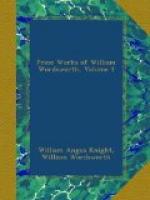I will take this opportunity of observing, that they who have studied the appearances of Nature feel that the superiority, in point of visual interest, of mountainous over other countries—is more strikingly displayed in winter than in summer. This, as must be obvious, is partly owing to the forms of the mountains, which, of course, are not affected by the seasons; but also, in no small degree, to the greater variety that exists in their winter than their summer colouring. This variety is such, and so harmoniously preserved, that it leaves little cause of regret when the splendour of autumn is passed away. The oak-coppices, upon the sides of the mountains, retain russet leaves; the birch stands conspicuous with its silver stem and puce-coloured twigs; the hollies, with green leaves and scarlet berries, have come forth to view from among the deciduous trees, whose summer foliage had concealed them; the ivy is now plentifully apparent upon the stems and boughs of the trees, and upon the steep rocks. In place of the deep summer-green of the herbage and fern, many rich colours play into each other over the surface of the mountains; turf (the tints of which are interchangeably tawny-green, olive, and brown), beds of withered fern, and grey rocks, being harmoniously blended together. The mosses and lichens are never so fresh and flourishing as in winter, if it be not a season of frost; and their minute beauties prodigally adorn the foreground. Wherever we turn, we find these productions of Nature, to which winter is rather favourable than unkindly, scattered over the walls, banks of earth, rocks, and stones, and upon the trunks of trees, with the intermixture of several species of small fern, now green and fresh; and, to the observing passenger, their forms and colours are a source of inexhaustable admiration. Add to this the hoar-frost and snow, with all the varieties they create, and which volumes would not be sufficient to describe. I will content myself with one instance of the colouring produced by snow, which may not be uninteresting to painters. It is extracted from the memorandum-book of a friend; and for its accuracy I can speak, having been an eye-witness of the appearance. ‘I observed,’ says he, ’the beautiful effect of the drifted snow upon the mountains, and the perfect tone of colour. From the top of the mountains downwards a rich olive was produced by the powdery snow and the grass, which olive was warmed with a little brown, and in this way harmoniously combined, by insensible gradations, with the white. The drifting took away the monotony of snow; and the whole vale of Grasmere, seen from the terrace walk in Easedale, was as varied, perhaps more so, than even in the pomp of autumn. In the distance was Loughrigg-Fell, the basin-wall of the lake: this, from the summit downward, was a rich orange-olive; then the lake of a bright olive-green, nearly the same tint as the snow-powdered mountain tops and high slopes in Easedale;




